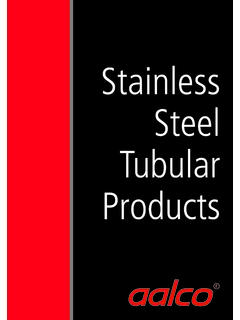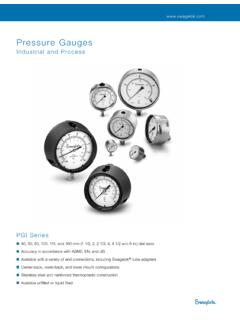Transcription of The Basics of Tube & Pipe Bending
1 The Basics of Tube & pipe Bending Tracto-Technik GmbH Spezialmaschinen Plant II y Rohrumformtechnik Hunold-Rump-Stra e 76-80 D-57368 Lennestadt Tel.: +49 (0) 27 25 / 95 40-0 Fax: +49 (0) 27 25 / 95 40-33 E-mail: Website: The Basics of Tube & pipe Bending Tracto-Technik GmbH, Plant II - 2 - by Michael Rohrmann January 2005. Tracto-Technik GmbH, D-57368 Lennestadt The Basics of Tube & pipe Bending Tracto-Technik GmbH, Plant II - 3 - C O N T E N T S 1.
2 Reshaping by Bending .. 4 2. Theory of the Bending Process .. 5 3. pipe Bending 12 4. Rotary Draw Bending .. 13 5. Application Fields of the pipe Bending Technology .. 14 6. Advantages of Tube / pipe Bending .. 16 7. Influences on pipe Bending .. 17 8. Quality of bent tubes / Pipes .. 18 The Basics of Tube & pipe Bending Tracto-Technik GmbH, Plant II - 4 - 1. Reshaping by Bending According to German standard, DIN 8580, the production methods are divided into the six main groups original forming, reshaping, joining, sepa-rating, coating and altering the material properties ( ).
3 Reshaping means working a stable body by ductile (plastic) alteration of the shape, while maintaining the mass and the material cohesion. The reshaping methods are divided into sub-sections according to the main stress, this has been regulated in DIN 8582. Characteristic for reshaping by Bending : the ductile condition (flow) is mainly carried out by Bending stress. We differ between Bending with straight-lined tool motions and rotating tool motions. From single to series production, not only sheet metal, but also pipes, wires, rods and profiles with different shaped cross-sections can be bent, using a multitude of different methods.
4 Normally, the work pieces are bent under cold conditions. The work piece has to be heated only when working with very thick sheet metal or very small Bending radii, in order to keep the required Bending forces down and to avoid brittleness of the material due to low temperature. Figure 1: Classification of the production methods according to DIN 8580. The Basics of Tube & pipe Bending Tracto-Technik GmbH, Plant II - 5 - 2. Theory of the Bending Process When metallic working materials are bent in cold condition (below their recrystallization temperature), at first an elastic shape alteration takes place, which is replaced by a ductile shape alteration from a certain degree on.
5 If the reshaping capacity is run down, the work piece breaks. This elas-tic-plastic behaviour of metallic materials is reflected in the stress-strain-diagram (see ) determined by tensile tests. Within the range of the elastic line (Hooke's law), a tensile sample is reshaped elastically; as soon as the strain is relieved, the body returns to its original shape. However, if the applied tension exceeds the elasticity limit, the shape of the sample is permanently altered. The degree of resiliency after the strain has been removed, results from the elastic part of the shape altering process, which has been stored in the sample as potential energy beforehand.
6 The altera-tions of shape occuring when metal pipes are being bent are mainly deter- = stress F = tensile force 0S = initial area = strain L = actual length 0L = initial length eR = yield point mR = tensile strength A = elongation at break eHR = upper yield point eLR = lower yield point Figure 2: Stress-strain-curve. The Basics of Tube & pipe Bending Tracto-Technik GmbH, Plant II - 6 - mined by the material-specific parameters modulus of elasticity and yield stress.
7 Due to the elastic-plastic behaviour of metallic materials, the pipe springs back by a certain angle after every Bending attempt. Besides the resiliency, there are also other inevitable phenomena to regard, where shaping by Bending is concerned: the spring-back of the radius, oval deformation of the cross section (round pipes and tubes ) as well as changes in the length of the work piece and formation of wrinkles. The elasticity is the reason for the spring-back of the pipe after the bend-ing process has been completed ( ).
8 While in the valid range of "Hooke's law" (elastic line), the shaping energy is completely given back as work of elastic strain in the form of resiliency. But after the external strain has been re-moved, it is partly dissipated as work of plasticity when per-forming the elastic-plastic shaping. In this case, the extent of spring-back is only caused by the elastic (reversible) part of the shaping work, which is stored in the pipe as potential energy during the Bending process. Spring-back is an inevitable phenomenon of Bending , and can only be compen-sated by overbending the work piece.
9 Spring-back of the bend: 1221 = = Rate of spring-back: springbackbeforeanglebendingspringbackaf teranglebending==12 Figure 3: Spring-back (acc. to Franz). The Basics of Tube & pipe Bending Tracto-Technik GmbH, Plant II - 7 - In the so-called Bending curve (see ) the spring-back, depending on the Bending angle with otherwise identical Bending parameters, is dis-played. Always the same typical progression is recognisable.
10 A steeply ris-ing linear phase (purely elastic forming) is followed by a non-linear phase (elastic-plastic Bending phase, plasticizing in cross section) and then by the weak linear rise of a further range (plasticizing in the longitudinal section only) up to the end of the Bending process. Spring-back of the pipe after relief of the strain is also followed by a slight increase of the Bending ra-dius, but this can already be considered when fabricating the Bending tools.

